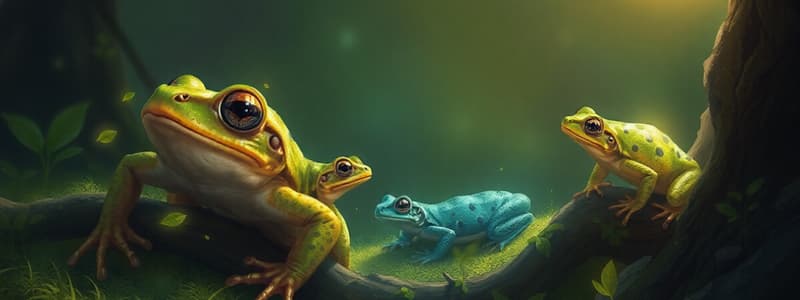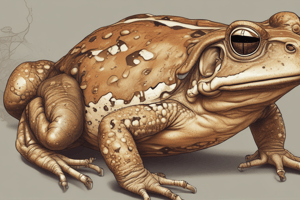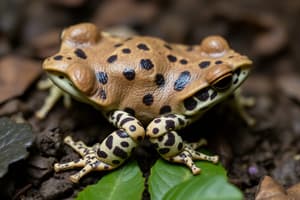Podcast
Questions and Answers
Flashcards
Toad egg
Toad egg
The first stage in a toad's life cycle, where it begins as a small, black dot surrounded by a clear, jelly-like substance.
Toad embryo
Toad embryo
The undeveloped baby toad inside the egg, similar to a human embryo.
Tadpole
Tadpole
The second stage in a toad's life cycle, characterized by a tail and gills, allowing them to breathe underwater.
Metamorphosis
Metamorphosis
Signup and view all the flashcards
Toadlet
Toadlet
Signup and view all the flashcards
Jelly-like substance
Jelly-like substance
Signup and view all the flashcards
Algae
Algae
Signup and view all the flashcards
Toad egg strand
Toad egg strand
Signup and view all the flashcards
Tadpole to toad
Tadpole to toad
Signup and view all the flashcards
Adult toad
Adult toad
Signup and view all the flashcards
Study Notes
Toad Life Cycle
- Toads undergo metamorphosis, a complete change in form during development. Humans, unlike toads, do not change form dramatically.
Stage 1: Egg
- Toad eggs are encased in a jelly-like substance.
- Females lay hundreds or thousands of eggs in ponds or streams.
- A tiny black dot inside the egg is the embryo.
- Some eggs do not survive.
Stage 2 & 3: Tadpole & Toadlet
- Eggs hatch into tadpoles (also called pollywogs).
- Tadpoles have tails and gills, needing water for breathing.
- They have jaws for eating algae.
- Toadlets resemble small toads, with legs developing.
- Toadlets have sticky tongues, and lungs allowing them to breathe air and survive on land, but they need water to prevent dehydration.
Stage 4: Toad
- The mature toad lacks a tail and has fully developed lungs.
- The toad has four legs for jumping.
- Adults start looking for mates.
- Females become ready to have babies around three years old; males around two years old
- During mating season, male toads call to attract females.
- This triggers an egg-laying cycle.
Studying That Suits You
Use AI to generate personalized quizzes and flashcards to suit your learning preferences.




